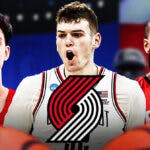During the third-quarter nadir of the Portland Trail Blazers' “embarrassing” loss to the LA Clippers, there were a few fleeting moments that made it easy to wonder if everything was alright with Damian Lillard.
He'd just airmailed another three-pointer, threw a pocket pass to Jusuf Nurkic's heel and came up short on a half-contested layup. Lillard's defensive effort didn't exactly suggest he had much interest in bringing Portland back from a burgeoning double-digit deficit, either.
All of which begged the question: Was Lillard really fully healthy, or laboring through some unknown physical malady? Just as that concern seemed more warranted than ever, Lillard forcefully put it to rest. It's easy to forget that he participated in the ill-fated 2014 dunk contest at All-Star weekend. That was over seven years ago now, but Lillard tried to turn back the clock with this towering poster dunk over Isaiah Hartenstein anyway, despite his team's deficit approaching 30 points.
So much for the notion that Lillard isn't right physically.
But something is definitely wrong with the Blazers' franchise player. How else to explain his 2-of-24 start to the season from beyond the arc and a -5.8 net on-off rating, per NBA.com/stats, worst among Portland starters?
Here are three keys to Lillard breaking out of his ugly early-season slump.
Playing Selfish
Chauncey Billups talked a big game during the offseason about lessening the playmaking burdens of Lillard and C.J. McCollum, his egalitarian, motion-heavy offensive system naturally decreasing their time on the ball. Lillard's per-game numbers were almost bound to dip in 2021-22 as a result. The trade-off wasn't just supposed to be an uptick in his overall efficiency, but a reserve of additional energy Lillard could tap into when Portland needed him most come crunch time and the playoffs.
Three games into the regular season, though, Lillard has been more adversely affected by the Blazers' shifting offensive identity than any of his teammates, an especially big surprise given his self-professed comfort in Billups' system as exhibition play came to a close.
“I have a good understanding of what we're trying to do,” Lillard said on October 14th, forecasting and justifying his absence in Portland's preseason finale. “I feel good on the floor.”
Maybe his early labors really are a reflection of that comfort as much anything else. Billups hinted as much after the loss to the Clippers, suggesting that Lillard is going out of his way to make sure the Blazers at large feel good operating their new attack—at the expense of his own offense.
Here's Chauncey Billups from last night on Dame's struggles. Expect to see Lillard come out with much more pointed aggression against Grizzlies on Wednesday. pic.twitter.com/TwSnXejqf6
— Jack Winter (@ArmstrongWinter) October 26, 2021
Lillard has proudly spoken in the past about his ability to flip the switch from getting his teammates involved to creating offense for himself, a luxury reserved solely for the game's truly elite playmakers. That distinction obviously still applies to Lillard; one of the worst three-game stretches of his career doesn't change that.
But even accounting for his unwavering confidence, it was always naive for Lillard and anyone else to blindly assume he would have no trouble acclimating to Portland's overhauled offense. Let's see if Lillard looks out for himself first and foremost against the Memphis Grizzlies on Wednesday, playing with pointed aggression and force as a scorer from the opening tip that he'd prefer to exercise more willingly.
Simplifying The Offense
The Blazers haven't exactly fully embraced Billups' offensive tenets ball and player movement, getting to multiple sides of the floor in the halfcourt and pitching ahead in transition. He lamented that reality following Monday's loss, expressing specific frustration about their “backslide” after the coaching staff emphasized everything they did well offensively in Saturday's blowout win over the Phoenix Suns.
But Billups, clearly, has come to accept that Portland's offense will sometimes devolve into the staid pick-and-roll and dribble hand-off-based approach that plays into the natural dribble-dribble tendencies of Lillard and McCollum. With the former mired in outlier shooting woes, why not make it easier for Lillard to shrug them off with the Blazers occasionally reverting back to their former offensive principles?
Early double-drag screens and empty-corner side pick-and-rolls have been Lillard's bread and butter for years. He's looked good turning the corner to attack the rim downhill and finding rollers with pocket passes when the ball is forced from his hands. The next step for Lillard is simply finding his jumper, and affording him a longer leash to run those basic actions early in the shot clock is the simplest means of him doing it.
Making Jumpshots
Lillard almost anticipated his shooting struggles in the season-opening loss to the Sacramento Kings.
“I probably made 25 [threes] in a row this morning during shootaround, and in my head I was actually thinking, like, ‘Man, whenever I shoot good in the morning and shoot good pre-game, those are the games I don't make a lot of shots,” he said after the game. “It's crazy that it actually happened.”
Lillard misfired on all nine of his three-point attempts against Sacramento, tied for the most he's ever missed without a single make. He's 2-of-15 from deep since then, clanking makable jumper after makeable jumper. Lillard also has just two total baskets outside the restricted area this season.
Here's how a few of his shots against the Clippers looked just before Lillard let fly. These aren't the easiest looks, of course, but plenty good for a shot-maker of his all-time caliber.




Lillard established himself as one of the 75-best NBA players ever by regularly connecting on a steady diet of tough shots that resembled those above. There's nothing in Portland's updated offense that makes them inherently more difficult, either.
The best way for Lillard to emerge from his current depths, basically, is just for the ball to go in the basket. Ask C.J. McCollum.
CJ doesn't seem too worried about Dame's struggles, either. #RipCity
“It's only a matter of time until he's hitting 30-footers again.” pic.twitter.com/8ljIJY9B6q
— Jack Winter (@ArmstrongWinter) October 26, 2021
Will Wednesday's game be when those 30-footers start to fall? Prioritizing his own offense ahead of his teammates' and re-embracing early-clock ball screens could go a long way toward Lillard playing like himself again. But the truth is the make-or-miss nature of jump-shooting allows lots of room for that possibility all by itself.




